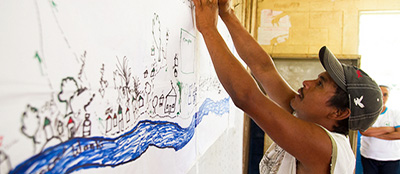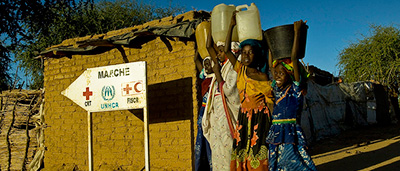Syria and Yemen are both experiencing immense humanitarian and development challenges. Violent conflict, political and civil unrest, rising food and fuel prices, mass unemployment and breakdown in social services have contributed to massive displacement, food insecurity and acute malnutrition, difficult living conditions, lack of basic services and poor housing. Neighbouring ...» more
Humanitarian Issues
UN Peace Support Mission Transitions
This report provides an overview of the available analysis on UN peace support transitions. The term transitions refers to situations where peace support operations withdraw and hand over responsibility to national authorities, another UN body such as a UN country team, an alternative international presence, or other regional and local actors. The available literature is mostly ...» more
UN Peace Support Mission Transitions – Nepal
While there have been several research studies that reflect on the achievements and challenges facing the UN Mission in Nepal (UNMIN), there has been very little analysis of the transition from UNMIN to a UN country office, which took place in January 2011. Much of the analysis of the transition detailed in this report relies on UN documents and is generally uncritical. UNMIN ...» more
UN Peace Support Mission Transitions – Haiti
United Nations peace operations in Haiti date back to September 1993, when the Security Council set up the first UN peacekeeping operation in the country – the United Nations Mission in Haiti (UNMIH). Since then, Haiti has been somewhat of a ‘playground’ for the evolution of UN peacekeeping. Early missions (UNSMIH/UNTMIH) were characterised by narrow remits addressing ...» more
UN Peace Support Mission Transitions – Sierra Leone
The United Nations Assistance Mission in Sierra Leone (UNAMSIL) began in 1999. At its height in 2001 it consisted of some 17,500 personnel. The mission had a strong influence on how the integrated mission concept is understood and applied today, particularly with regard to integrating humanitarian politico-military efforts and the UN system in the country, operating under the ...» more
Incentives to the Private Sector and Early Recovery
This report assesses examples of donor interventions designed to influence the incentives facing the private sector (PS) with the overarching aim of supporting early recovery. For the purposes of this report early recovery will be understood as 'a multidimensional process of recovery that begins in a humanitarian setting' (CWGER 2008, p.9). This report will focus primarily ...» more
Donors’ and agencies’ humanitarian protection frameworks
This report provides information on the strategy documents that frame different donors’ and humanitarian agencies’ approaches to protection, and highlights the key focus of each document. Many definitions of humanitarian protection exist, with many donors supporting, and agencies undertaking, protection activities. These are mostly in situations of conflict, or as a result of ...» more
Multi-Year Funding to Humanitarian Organisations in Protracted Crises
There has been growing consensus amongst donors that multi-year funding is a critical tool for improving the allocation and effectiveness of humanitarian aid to protracted crises. A number of donors have developed mechanisms to allocate funding in these contexts on a multi-year basis, channelling funding directly to NGOs, the UN and other multilateral agencies, and to ...» more
Donor Initiatives to Engage with South Sudanese Diaspora
This report provides details of donor programmes designed to engage with the South Sudanese diaspora with the goal of supporting their development efforts in the country. It also provides details of similar programmes with the Somali diaspora and diaspora from other post-conflict states in Africa. A small number of initiatives are currently being undertaken with the South ...» more
Key Resources on Gender and Humanitarian Responses
This helpdesk report identifies some of the key resources on gender and humanitarian action. The most widely relevant, rigorous and accessible resources have been selected. This selection is based on the author’s own review of the available literature and on recommendations from a number of gender experts and practitioners. Within their sections, the resources have been ...» more
Support to Public Administration Reform in Central and Eastern Europe
In general MDTFs are a popular way of organising donor support for public administration reform (PAR) in difficult transition environments. The perceived benefits are: lower transaction costs for donors coordination of donor priorities and approaches attracting a wide range of donors to contribute facilitating easier harmonisation with country strategies and ...» more
The World Bank in Fragile States
Some of the recurring findings from the literature on the World Bank’s performance in fragile and conflict-affected states include the following:Despite efforts to become more conflict-sensitive, the Bank’s approach to conflict-affected and post-conflict states focuses more on ‘doing things differently’ than ‘doing different things’. This is partly due to a continued reluctance ...» more
Aid Interventions on Gender and Conflict
Many experts point out that the impact of aid interventions on gender, especially in post-conflict settings, is rarely measured. Most of the literature on aid programmes that is available often takes a more critical perspective, with a view to suggesting what could have been done better. As a result, there is relatively more information on the strategies which are considered ...» more
Non-State Providers of Health Services in Fragile and Conflict-Affected States
Most mechanisms that use NSPs to deliver services are only being applied at a very small scale in fragile states. There is some evidence that the most widely used mechanism - contracting - can increase service utilisation, increase service quality, improve efficiency, reduce service fragmentation, and support strengthening of national capacity. The basic package of health ...» more
Service Delivery and Stabilisation
There is very little evidence on the impact of stabilisation service delivery initiatives on producing a peace dividend, or providing the basis for longer-term sustainable reform.Nevertheless, the most commonly cited potential benefits of service delivery in post-conflict environments are that visible delivery enhances state legitimacy, strengthens the social contract and ...» more
Reintegration in Aceh/Post-conflict Environments
The situation in Aceh differs from other conflict environments in that most combatants have remained close to their communities during the conflict, with some never having left their villages. As such, minimal tensions are reported between former combatants and ‘receiving communities’. Reintegration measures have thus focused more on economic reintegration rather than social ...» more
Post-conflict Rehabilitation of Education Services
Education systems can contribute to conflict. In Rwanda, for example, the education system was used as an instrument in fomenting exclusion and hate. In many post-conflict settings, rehabilitation of the education sector requires not re-establishing the system that existed prior to the conflict but rather reforming the whole system. Education rehabilitation goes beyond ...» more
Social Assessment in Disaster Reconstruction
A ‘social assessment’ has broadly two functions: to assess the social impact of the disaster itself; and to analyse and manage the social consequences of reconstruction interventions. There seems to be relatively little material on the latter in post-disaster contexts. This query therefore focuses on the two related components of such an assessment.The first is meaningful ...» more
Intangible Heritage and Post-Disaster Protection
Key findings: The protection of intangible cultural heritage has increased in prominence in recent years. Natural disasters and man-made disasters have destroyed and threatened much tangible and intangible cultural heritage (e.g. building typologies and skills, handicraft traditions, communal livelihoods and traditions, social relationships and ecological balances). Much of ...» more
Community Participation in Disaster Rehabilitation and Recovery
Much of the literature on participation in emergencies focuses on the role of community engagement in disaster preparedness. However, the literature that does address participatory approaches in disaster-affected contexts highlights the advantages, which include better analysis, effective programming and implementation, and increased accountability. In addition, such ...» more


